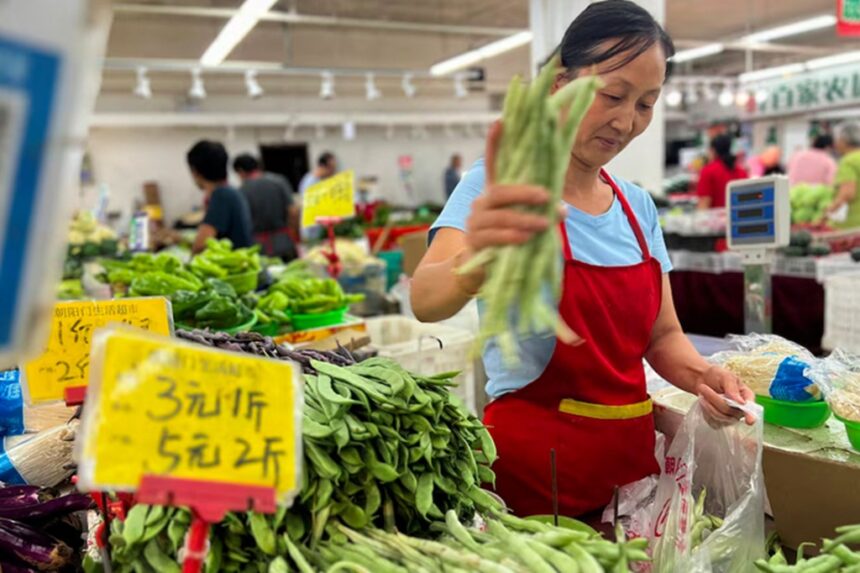BEIJING – China, home to the world’s second-largest economy, is wrestling with stubborn deflation, with factory prices hitting their lowest point in almost two years by May 2025.
A mix of ongoing price drops, sluggish factory output, and the impact of fresh US tariffs is putting more strain on an already shaky economic situation. Retail sales are growing weakly, unemployment remains high, and core inflation is only just starting to show small signs of improvement. As Beijing deals with these setbacks, worries are rising over whether current policies can stabilize the economy or if China faces a long period of falling prices.
China’s producer price index fell by 3.3% year-on-year in May 2025, marking the biggest drop since July 2023, as reported by the National Bureau of Statistics. This followed a 2.7% fall in April, signalling that factory gate prices are dropping at a faster pace. The consumer price index dipped by 0.1% year-on-year in May, matching previous months and falling short of expectations.
Deflation is proving tough to reverse. Consumer prices have stayed negative for two straight years, and if this pattern holds, it would be China’s longest bout of deflation since the 1960s. Core inflation, which leaves out food and fuel, edged up to 0.6% in May from 0.5% in April, but experts say this rise is weak. Zichun Huang from Capital Economics commented that overcapacity will likely keep China in deflation this year and next.
Deflation, triggered by weak demand and lower prices, can set off a damaging cycle. People hold off on spending, expecting things to get cheaper. As a result, businesses slow production and reduce jobs, worsening the slowdown.
This pattern is clear in China’s soft domestic demand, made worse by a struggling housing market, high personal debt, and job worries. Zhiwei Zhang of Pinpoint Asset Management pointed out that deflationary pressure remains strong and may even increase as export problems continue.
US Tariffs Batter China’s Export Sector
Trade tensions with the US have become a key reason for China’s deepening economic problems. Tariffs imposed by the US, including a jump to 145% on Chinese imports in April 2025 (later reduced to 51.1%), have badly hurt China’s manufacturing exports.
Customs data showed a 34.5% year-on-year drop in shipments to the US in May, the biggest fall since early 2020 at the start of the pandemic. Overall export growth slipped to 4.8% in May, down from 8.1% in April and below forecasts.
Tariff pressure is hitting factory activity hard. The Caixin/S&P Global manufacturing PMI dropped to 48.3 in May, below the 50 mark that separates growth from contraction. This marked the steepest contraction since September 2022. New export orders hit their lowest point since July 2023, highlighting the drop in demand from abroad. On top of this, falling world commodity prices, especially oil, and lower seasonal energy demand have made factory-gate deflation worse.
Beijing’s effort to sell more goods at home to make up for lost exports is also causing problems. The extra goods are flooding a slow-moving consumer market, adding to the issue of too much supply and pushing prices down even further. Julian Evans-Pritchard from Capital Economics warned that deflation will likely get worse in the coming months as Chinese companies find it harder to sell their surplus overseas.
China’s domestic economy is feeling the squeeze. Retail sales growth slowed to 5.1% year-on-year in April, down from earlier, stronger results. This drop points to cautious shoppers who feel insecure about their jobs and see little movement in house prices. Car sales, an important sign of consumer strength, rose by 13.9% in May, down from 14.8% in April. The property sector, which underpins much of household wealth, is stuck in a long slump, which is dampening consumer confidence.
Unemployment, especially among young people, adds to the challenge. In August 2024, youth joblessness for those aged 16-24 (excluding students) hit 18.8%, the highest in eight months. Urban unemployment has stayed above 5% for the past year, with patchy wage growth limiting spending. With job worries and weaker property values, many families are saving rather than buying, feeding the deflation cycle.
Beijing’s Response: Can Policy Make a Difference?
China’s leaders face mounting pressure to act. In May 2025, the People’s Bank of China cut key rates by 10 basis points and lowered the reserve requirement ratio by 50 basis points to free up more cash in the system.
Beijing also doubled support for a consumer trade-in plan to 300 billion yuan (about £32.5 billion) to lift demand for mid-range phones and home appliances. Premier Li Qiang announced new fiscal steps targeting 5% GDP growth in 2025, a target many see as tough to reach in current conditions.
But there are doubts about whether these efforts go far enough. Bruce Pang from the Chinese University of Hong Kong said that while these policies might help consumer prices recover slowly, pressures on factory prices will likely stick thanks to uncertain oil prices and weak global demand. Ting Lu of Nomura called for more ambitious action to fix the housing downturn and lift spending, warning of trouble from both trade disputes and real estate problems.
The government’s focus on high-tech and state-owned firms, as stressed by President Xi Jinping, has faced criticism for not doing enough for private businesses and household incomes. Many experts say a wider approach is needed, including targeted help to boost confidence and deal with issues like having too much capacity.
Global Effects: China’s Deflation Spreads
China’s deflation is spreading beyond its borders. Cheaper exports and a weakening yuan, which sat near long-term lows at 7.3469 per dollar in April 2025, are adding to disinflation in other countries.
US import prices from China dropped 4.1% over the three months to July 2023, and the eurozone saw a 15% drop, showing the worldwide impact. This puts extra strain on producers in other markets, especially in fields like steel, electric vehicles, and solar products, where Chinese competition is tough.
While a long-term deflation period like Japan’s seems unlikely due to China’s strong manufacturing base and large domestic market, failing to address weak demand and overcapacity could make the deflation problem worse and raise financial risks, especially with China’s high debt.
China’s economy faces major hurdles. Continued deflation, slowing factories, and the fallout from US tariffs are challenging Beijing’s ability to keep growth on track. Recent policy moves show intent, but their real impact is not yet clear, especially given deeper issues like overcapacity, a weak property market, and high unemployment. Analysts expect consumer prices to rise by only 0.3% in 2025, the smallest increase since 2023, underlining the scale of the challenge.
Trade talks between the US and China are set to continue, with negotiations moving to London. The coming months will reveal whether China’s economy can break out of this cycle or if deflation will stick around even longer.














